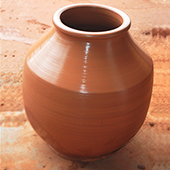Design Resource
Traditional Ghatam Making - Madurai, Tamil Nadu
Pani Mataqa Making
by
Prof. Bibhudutta Baraland Rakshitha
Clay is the main substance used to make this instrument. Using some suitable alloys and chemicals proportionately to clay results in causing different sounds of specific pitch. In fact the soil science plays a vital role to create the most entertaining source for the humankind. In case if the aspect of soil governance is not taken into consideration then the result could cause the distress. Thus the artist analyzes the soil sample in more efficient way. Hand analysis is the easier way to detect the physical properties of the soil.
The clay used for ghatam making is been collected from five-six ponds. Every clay sample has its own apparent moisture content, porosity, absorption capacity, density and specific mechanical strength. Thus the quality of clay is the most important factor that has to be taken care of. The clay is allowed to dry for two days. The components of the mud are separated by sieving and dissolving in water followed by filtration. Then the mud is mixed with the sand collected from Vaigai River. An appropriate amount of lead and graphite are added to it, to improve the tone. This mixture is rich in calcium lime, ash, red lead, sodium silicate, manganese, iron and plasticine which enhances the metallic sound of the instrument.This mixture is further stamped completely for six hours (Kneaded with the leg) and kept aside for two days. After two days, when the clay gets stronger it is used for casting the pot.
A lump of clay is put in the centre of electric wheel. As the wheel starts turning, the clay is shaped with hands. When the pot is shaped it is taken out from the wheel and set for tempering. The tricky part lies here in this stage. The tempering of ghatam is the trickiest part used to improve the tone. Artist holds the pot in left hand and rotates the stone inside the pot to check the strength of the wall and to smoothen the surface. Later by using a wooden spatula and stone, beating gets resumed. At this point the instrument weighs nearly 16kgs. Once the beating gets finished it is dried in shade for couple of weeks and then warmed for four hours under a fierce sun. Later yellow and red polishes are applied to the pot and fired in the kiln for twelve hours. At this very point half of the instrument’s weight is shed when baked. Thus the final product weighs nearly 8kgs that makes the beautiful music!
Flow Chart:







































